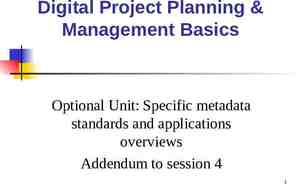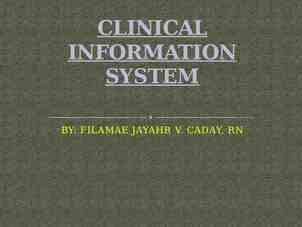Health Home Criminal Justice Workgroup NYSDOH, Health Home
25 Slides169.61 KB

Health Home Criminal Justice Workgroup NYSDOH, Health Home Program August 25, 2016

August 25, 2016 2 Agenda: 15 min. Welcome and Introductions 15 min. Update on Funding for Health Homes and Criminal Justice Involved 15 min. Update on Waiver for Transitional Services 45 min. Health Home Pilot Updates 30 min. Next Steps

August 25, 2016 3 Funding Update

August 25, 2016 Waiver Update As part of the FY2017 Enacted Budget, the Governor supported the submission of an application to CMS for a Medicaid waiver to cover certain services and pharmaceuticals provided to an inmate 30 days prior to release from a corrections facility. A concept paper that was developed by DOH which has been shared with CMS and is the framework that will guide the waiver submission. Required public notices have been submitted. 4

August 25, 2016 Health Homes and the Justice Involved Bronx Accountable Healthcare Network Health Home (BAHN) Bronx Lebanon Hospital Brooklyn Health Home Community Healthcare Network Coordinated Behavioral Care (CBC) HHUNY, Huther Doyle HHUNY, Lake Shore 5

August 25, 2016 6 Health Homes and the Justice Involved

August 25, 2016 7 Bronx Accountable Healthcare Network (BAHN) Montefiore Medical Center Health Home Antonette Mentor

August 25, 2016 Successes Established data exchange agreement with DOHMH (pending reassignment of contract to Health and Hospitals Corp. Division of Correctional Health Services) Monthly refreshed list of BAHN Members sent to the Division of Correctional Health Services and returned with anticipated release date and discharge planning unit assignment – Utilized by CMA partners to plan for outreach and/or re-engagement BAHN CMAs are connected with the discharge planners on Riker’s Island Regular status meeting with Correctional Health Services Team Contracting in progress with a CMA with expertise in the justice-involved population Began dialogue with a referral source/program focused on the Forensic Population released from Riker’s island Developing a relationship with a Transitions Clinic Exploring care management models i. Embedded care manager located in the clinic ii. Partnership between the Transition Clinic and the CMA that is on-site at the jail system 8

August 25, 2016 Successes cont. Expanded Education Support to the CMAs / Tools Diligent Searches for Members that are lost Utilizing NYC Inmate Lookup » http://a073-ils-web.nyc.gov/inmatelookup/pages/common/find.jsf Department of Corrections and Community Supervision » http://nysdoccslookup.doccs.ny.gov/ 9

August 25, 2016 Challenges CMAs are challenged by absence of funding for work that begin before members are released Other CMAs are able to “invest” in this unbillable effort to mitigate the risk of losing members but have expressed difficulty in sustaining the practice Limited direct engagement opportunity during incarceration; increases risk of disconnection from Health Home Health Home Care Management is not regarded as a key resource in meeting basic needs upon release 10

August 25, 2016 11 Brooklyn Health Home Hannah Loeffert

August 25, 2016 Successes Identified successes Intercept Points: Correctional Health Services at Rikers Island Jail Referral Sources: Data match process Engagement Process: written, telephonic outreach during detainment & incarceration; face to face intake sessions in the community, “warm hand offs” upon referral from community vendors Updating of consents to include relevant legal supports and resources, updated comprehensive assessment and care plan, exploration of relevant support services (e.g. medication delivery, NYCHA Reentry Housing, vocational case management etc) Enhancing Cultural Competency Providing monthly meetings for care management network to discuss care management strategies, cultural competency, trainings available in the community to enhance ability to work with population effectively (includes presentations from vendors that have demonstrated expertise or comfort in working with citizens with justice system history) Development of policy & procedure, workflows, and tools to assist care managers in building and maintaining effective relationships with justice system stakeholders and citizens 12

August 25, 2016 Data BHH has observed over 3,400 admissions to the jail since Correctional Health Services project start (est. 2014) Rates of re-admission to the jail for BHH enrolled members 2015 will be compared to 2016 rates after close of final quarter Caseloads still average a minimum of 40:1 as a result of care management rates; BHH has recruited three agencies with history of justice system expertise; one care management agency has dedicated a FTE to working with justice involved clients Highest volume of justice cases are identified through partnership with Correctional Health Services (data matching) Prevalent needs include: housing, family reunification, entitlements, access to mental health/medical support, medication assisted therapy, trauma informed care, and vocational support Common services include enhanced care planning, in person support traveling to/from appointments, housing access/application completion, benefits/entitlements application completion (all five core services) 13

August 25, 2016 Challenges Need to secure high-quality trauma-informed care in both medical and behavioral (integrative) health settings; identification of reliable and timely services is challenging Medicaid suspends after 31 days of admission to jail; reactivates following release but not immediately; rendering some citizens unable to access care immediately upon discharge to the community Discharges are not always able to be coordinated as these sometimes happen directly at the court (staffing models cannot afford to deploy care managers to court settings for each appointment) and thus pose challenges in being able to implement discharge plans with member in real time Housing barriers continue to contribute to challenges in connecting with members post-release (unstably housed/homeless) Data matching, alert distribution manual efforts requiring dedicated HH staff Intensive level of aftercare interventions needed are difficult to balance alongside traditional HH caseloads (all are fairly intensive needs); staff struggle to allocate time as needed to each case 14

August 25, 2016 15 Bronx Lebanon Hospital Dr. Isaac Dapkins, MD

August 25, 2016 Successes Identified successes Long standing working relationship with the Transitional Health Services at Rikers. Transitional Health Services notifies Bronx Health Home of transitioning clients BLHH provides assists in providing care coordination resources. Referrals are categorized as urgent and addressed immediately. Most unassigned Rikers members are assigned to Bronx Tasc Care Coordination Any evidence based practices? Since 1986 EAC has operated Treatment Alternatives for Safer Communities (TASC), a national program model designed to break the addiction-crime cycle of drug-involved offenders by moving the offender through the criminal justice process and into drug and or mental health treatment, simultaneously providing monitoring services as an adjunct to criminal justice supervision. TASC comprehensive case management services create a unique interface among the criminal justice system, the treatment service system, and the offender, thus allowing for effective and efficient outcomes. 16

August 25, 2016 Data Referrals from Rikers are received on a bi-weekly basis. On an average 5 -10 members per month. 15 engaged, 30 in outreach, and an additional 12 in short term state prison (hiatus) There is a separate process for engaged clients that are HARP enrolled 20-30 clients Rikers is the most frequent referral source. Common needs are housing, behavioral health, medical health and employment. Common services provided are linked to experienced Care Coordination 17

August 25, 2016 Outcomes 2/15 of engaged clients in the most recent month were seen by a medical provider For clients remaining in “outreach status” the recidivism rate is higher than those Substance abuse rate is extremely high 18

August 25, 2016 Challenges At this time only Bronx Tasc is receiving the referrals from Rikers; this was at Rikers requests because volume is low and patients require high level of intervention There is no mechanism for care coordinators to actually meet with clients PRIOR to transition so many remain in outreach. We need to engage more partners that could service this population. 19

August 25, 2016 20 Huther Doyle Health Home Paula J. Randall, VP of Health Services

August 25, 2016 Successes Identified Successes Referral sources - Monroe County Jail Engagement process – Set up CM in Jail prior to exiting to complete Enrollment – Build Relationship/Make a Connection Services provided – Connect to: DHS, Housing, SUD/MH services, PCP, HS/College, P.T. Job Evidence Based Practices Hired previous recipient of CJS as CM – Good Example Meet them at the Door 21

August 26, 2016 Data Data Observations Average caseload – 45-50 Most frequent referral source – Monroe County Jail Common Needs – Signing up for DHS Services, SUD/PCP-Medication Management, MH Counseling Common Services Provided – Attending Appointments/ Follow Along for Common Needs 22

August 25, 2016 Challenges Barriers to Linkage and Care Not enough MH Providers Common Challenges 5:30 A.M. at the Door Losing them the First Day - Once they Hit the Streets-Difficult to Find Overcoming Challenges Be Present when Released Identify with Population 23

Next Steps/ Discussion

Contact us: [email protected] (518) 473-5569






